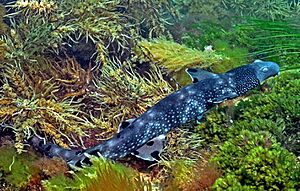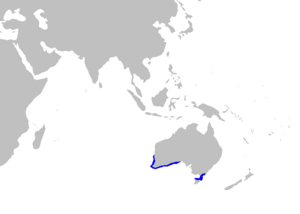Necklace carpetshark facts for kids
Quick facts for kids Necklace carpetshark |
|
|---|---|
 |
|
| The necklace carpetshark is usually found on or near the ocean floor. | |
| Conservation status | |
| Scientific classification | |
| Genus: |
Parascyllium
|
| Species: |
variolatum
|
 |
|
| Range of necklace carpetshark (in blue) | |
| Synonyms | |
|
Hemiscyllium variolatum Duméril, 1853 |
|
The necklace carpetshark (Parascyllium variolatum) is a type of carpetshark. It is also known as the varied carpetshark. This shark belongs to the family Parascylliidae. It is found only off the southern coast of Australia.
This shark lives near the ocean floor. You can find it over sand, rocks, coral reefs, and even in kelp and seagrass beds. It can live in waters as deep as 180 m (590 ft) (about 590 feet). The necklace carpetshark is mostly active at night. During the day, it hides in caves or uses its colors to blend in with the ocean floor.
Contents
All About the Necklace Carpetshark
The necklace carpetshark has a long, thin body. It can grow to about 91 cm (3 feet) long. This shark is completely harmless to humans. Its tail is long, but it's hard to tell where its body ends and its tail begins.
What Does it Look Like?
The body of this shark is grey to brown. It has a wide black band around its neck, which looks like a necklace. This is how it got its name! It also has white spots all over its body. The shark has small holes called spiracles behind its eyes. These help it breathe. It also has small feelers called barbels near its nostrils. These barbels probably help the shark sense things around it. People sometimes confuse it with a catshark. However, it is actually more closely related to wobbegongs and nurse sharks.
What Does it Eat?
The necklace carpetshark is a nocturnal predator. This means it hunts for food mostly at night. It mainly eats shellfish.
Life Cycle and Reproduction
Female necklace carpetsharks lay eggs. This way of reproducing is called oviparous. The eggs have curly parts that help them stick to the ocean floor. Inside the eggs, the baby sharks grow by feeding on a yolk, which is like their own food supply.


